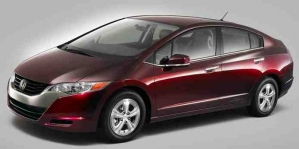 The transition has begun that will wean our society from gas powered cars to electric. As we strive to improve the environment and grapple with rising fuel costs, green electric cars are now on the minds of every auto executive and commuter. While there are “green ratings” for hybrid cars, which use a combination of gas and battery power, the only truly green vehicle that will ease your gas pump pain is one that uses no gas and features zero-emissions, like the electric truck by Phoenix Motors and the Hydrogen-powered Honda Clarity (right). If you are fortunate enough to be in a region where electric cars are sold, you can invest in transportation that is both kind to your wallet and a blessing to the environment. Expect more arrivals nationwide within 2 years.
The transition has begun that will wean our society from gas powered cars to electric. As we strive to improve the environment and grapple with rising fuel costs, green electric cars are now on the minds of every auto executive and commuter. While there are “green ratings” for hybrid cars, which use a combination of gas and battery power, the only truly green vehicle that will ease your gas pump pain is one that uses no gas and features zero-emissions, like the electric truck by Phoenix Motors and the Hydrogen-powered Honda Clarity (right). If you are fortunate enough to be in a region where electric cars are sold, you can invest in transportation that is both kind to your wallet and a blessing to the environment. Expect more arrivals nationwide within 2 years.
Green Cars This Summer
Yesterday, Honda Motor Company began commercial production in Japan of its new zero-emission, hydrogen fuel cell car, the FCX Clarity.
The FCX Clarity is a midsize four-seat sedan, which runs on hydrogen and electricity. It emits only water vapor and none of the gases believed to be responsible for global warming. Honda claims the vehicle offers two times better fuel efficiency than a gas-electric hybrid and three times that of a traditional gasoline-powered vehicle. The Clarity will initially be available for lease starting in July to a limited number of customers in southern California and then in Japan later in 2008.
Also available in California beginning this summer, from Green Vehicles headquartered in San Jose, are four short-distance all-electric models. The Moose and Microwatt attain speeds of 35 miles an hour or less, but the Triac, with three wheels, is made for highway driving. A work truck called the Buckshot is an alternative to a small pick-up truck.
Green Vehicles’ dealerships are only in San Jose and Mill Valley California, but there are plans to expand to other cites and to other countries.
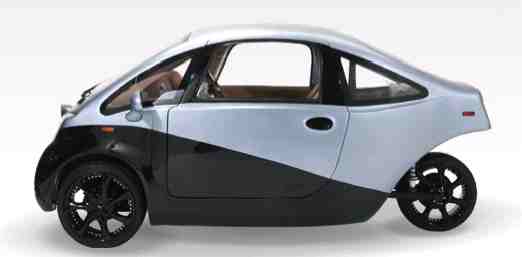 The vehicles can be charged using a 120V outlet. You can buy a fast charger that completes a charge in 2 hours, and for business fleet vehicles there is a charger that works in 30 minutes. The battery life is roughly 2000 charges which equates to 5 years of usage and these batteries are 98% recyclable. Green Vehicles indicate their cars cost $.02 cents per mile which is figured based a cost of 40 to 70 cents to recharge the battery divided by the number of miles you can drive on one charge.
The vehicles can be charged using a 120V outlet. You can buy a fast charger that completes a charge in 2 hours, and for business fleet vehicles there is a charger that works in 30 minutes. The battery life is roughly 2000 charges which equates to 5 years of usage and these batteries are 98% recyclable. Green Vehicles indicate their cars cost $.02 cents per mile which is figured based a cost of 40 to 70 cents to recharge the battery divided by the number of miles you can drive on one charge.
The TRIAC (right, above) is a three wheeled, 5 speed transmission vehicle that will retail for about $20,000. TRIAC has 80 mpg top speed and 100 mile range if driven at an average speed of 45 miles per hour. There will soon be an optional battery pack to add 25% more power Also it is equipped with a structural steel cage similar to that found on race cars which will protect in case of a collision. It has a 160 ah Lithium lon battery pack and a 144V/20KC Watt AC motor.
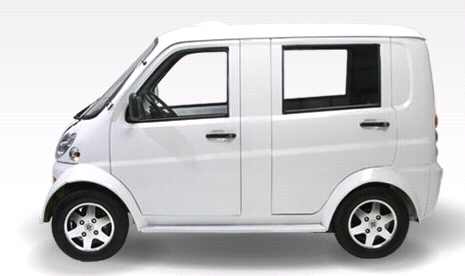 The MOOSE and MICROWATT are neighborhood vehicles for driving on any street where the speed limit is 35 mph or less. The retail prices are $12-13,000. With both 2-door Microwatt or 4-door Moose, the battery charges overnight when plugged in.
The MOOSE and MICROWATT are neighborhood vehicles for driving on any street where the speed limit is 35 mph or less. The retail prices are $12-13,000. With both 2-door Microwatt or 4-door Moose, the battery charges overnight when plugged in.
For deliveries, the 3-wheeled BUCKSHOT electric truck will come with a lockable cargo shell; for construction, a steel lumber rack; and for all-purpose functionality, a steel body with an extra-long bed and an ample passenger cabin.
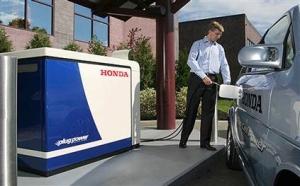 Hydrogen Vehicles
Hydrogen Vehicles
To address the availability of hydrogen recharging stations, Honda has come up with a home recharging scheme, that features what looks like a gas station pump for your driveway or garage. MSNBC reports, “A natural gas connection plugs into the station, which extracts hydrogen from the gas. For the car, hydrogen is pumped in like gasoline, powering either a fuel cell stack or an internal combustion engine modified to run on hydrogen.” The first hydrogen-powered cars available for sale aren’t expected for many years.
 GM is opening a hydrogen fueling station near the Los Angeles airport. This station will be used by drivers taking part in Chevrolet’s Project Driveway (the world’s largest market test of fuel cell vehicles) and it is expected to be operational by early fall, 2008. Another filling station opened in White Plains, New York. Project Driveway will utilize a test fleet of 100+ Chevrolet Equinox Fuel Cell crossover vehicles.The test vehicles will be placed with customers in Washington D.C., New York and California. The Equinox will go nearly 150 miles per fill-up and is capable of a top speed of 100 mph.
GM is opening a hydrogen fueling station near the Los Angeles airport. This station will be used by drivers taking part in Chevrolet’s Project Driveway (the world’s largest market test of fuel cell vehicles) and it is expected to be operational by early fall, 2008. Another filling station opened in White Plains, New York. Project Driveway will utilize a test fleet of 100+ Chevrolet Equinox Fuel Cell crossover vehicles.The test vehicles will be placed with customers in Washington D.C., New York and California. The Equinox will go nearly 150 miles per fill-up and is capable of a top speed of 100 mph.
Driving Green After 2008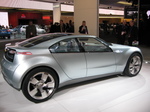
The GM VOLT is expected for sale in 2010, and to be different than any previous electric vehicle because it will use a lithium-ion battery that will automatically recharge while driving by using onboard gas or ethanol power sources. The Volt will be designed to use a common 110–volt household plug. For someone who drives less than 40 miles a day, the car will use zero gasoline and produce zero emissions. Chevrolet expects a driving range of 640 miles on one charge.
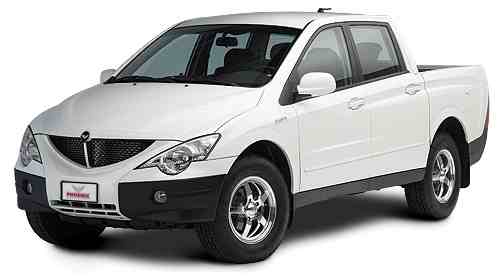 Phoenix Motorcars began in 2001 to manufacture two zero-emission, freeway-speed fleet vehicles. In late 2008, a limited number of Phoenix vehicles will be released to selected consumers in California and in 2009 a national release will begin. The Sports Utility Truck can cruise at speeds up to 95 mph while carrying five passengers and a full payload. See the GNN story from June, 2007, World’s First High-Speed All-Electric Sport Utility Truck
Phoenix Motorcars began in 2001 to manufacture two zero-emission, freeway-speed fleet vehicles. In late 2008, a limited number of Phoenix vehicles will be released to selected consumers in California and in 2009 a national release will begin. The Sports Utility Truck can cruise at speeds up to 95 mph while carrying five passengers and a full payload. See the GNN story from June, 2007, World’s First High-Speed All-Electric Sport Utility Truck
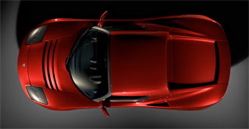 The Tesla Roadster is the first electric sports cars to hit the U.S. No gas and no emissions, plug in this gorgeous sports car for seven hours and you’re set for 200 miles of non-polluting fun! But the hefty pricetag is attracting mostly Hollywood stars and Silicon Valley CEO’s. Check out the Video on Good News Network featuring the Tesla model. See also the GNN-i report introducing the Tango, another sporty two-seater, made by Commuter Cars, Inc., that George Clooney drives around: 195 Miles per Gallon, Zero to 60 in Four seconds… The Electric Supercar is Here.
The Tesla Roadster is the first electric sports cars to hit the U.S. No gas and no emissions, plug in this gorgeous sports car for seven hours and you’re set for 200 miles of non-polluting fun! But the hefty pricetag is attracting mostly Hollywood stars and Silicon Valley CEO’s. Check out the Video on Good News Network featuring the Tesla model. See also the GNN-i report introducing the Tango, another sporty two-seater, made by Commuter Cars, Inc., that George Clooney drives around: 195 Miles per Gallon, Zero to 60 in Four seconds… The Electric Supercar is Here.
Stay tuned for news on the debut of green cars from Toyota, Mercedes Benz, Mazda and Volkswagon, all of which have announced work on vehicles that are more environmentally friendly and less gas dependent to be released in the next two years. Auto makers have heard the consumer’s fuel price pain and they seem determined to do their part to produce products to ease that pain.
(Additional editing and writing by Geri Weis-Corbley)




















While plugging in is IN why not charge the batteries as we go down the road? I have encountered nothing but negativity when I suggest that the wheels be outfitted with electric generators and that the vehicle be equipped with a wind generator. these are two energy sources that are wasted. How do I get this idea to the big designers? I want no money or reccognition just a non polluting car to get around when I need to. The plug still creates pollution that I feel today as I suffer from lung ailments.
It is good to see the electric cars are becoming a reality. It will really help with energy conservation. I know some think it just moves the pollution from the tail pipe to the power plant, but a power plant is more effecient at converting fuel to electricity.
To Mohayrix comment, a hybrid does have an electric generator attached to the wheels, it’s called regenerative braking which converts the energy of slowing the vehicle back to electricity. A wind generator is not a viable option since the car converts energy to move it and the wind generator on top would require more energy to move the vehicle to convert the wind back to electricity. It would be like standing on a small sail boat and blowing into the sail to make it go forward but you blowing forward makes you and the boat go backwards thus neutralizing the forward motion.
Ideallly, charge with solar panels, wind generators, etc. to eliminate the pollution.